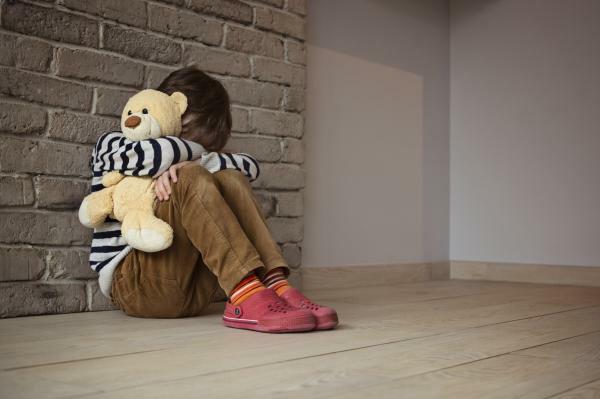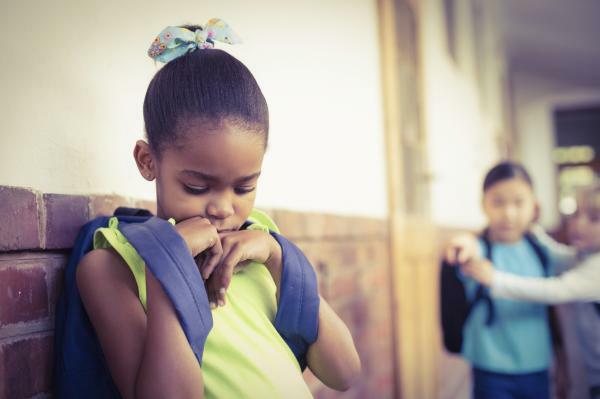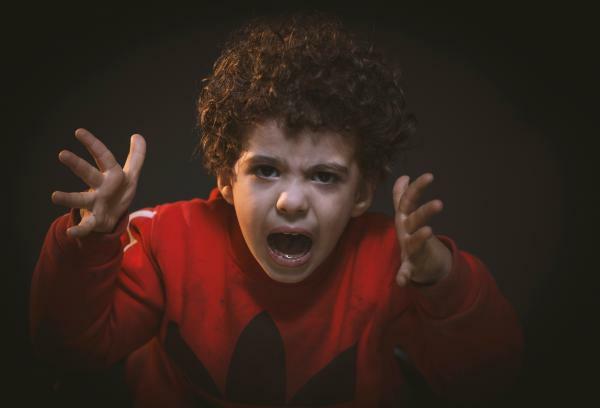
The knowledge of the risk factors that predispose the appearance of a certain morbid condition is a valid strategy for its prevention. This principle is applicable to suicidal behavior. In this PsychologyOnline article, we will mention the Suicidal Risk Factors in Childhood.
Index
- Suicidal risk factors in childhood
- Childhood Suicidal Crises: How Do They Work?
- The attitude of the family
Suicidal risk factors in childhood.
First of all, it must be considered that suicidal risk factors they are individual, since what for some is an element of risk, for others it may not represent any problem. In addition to being individual, they are generational, since the risk factors in childhood may not be so in adolescence, adulthood or old age. On the other hand, they are generic, since women will have risk factors unique to their condition and so will it be for men. Finally, they are culturally conditioned, since the suicide risk factors of certain cultures may not be so for others.
Let us now list the suicide risk factors in childhood that contribute to the development of behaviorsuicide in adolescence.
As is known, it is considered that below 5 or 6 years, children have a very rudimentary concept of what death or dying is, so it is practically unlikely to actively participate in death. In this stage death is represented, personified or objectified as a person with good or bad intentions, or an unpleasant or peaceful place. Also at these ages it is common for death to be associated with old age and disease. Above this age, death begins to be considered as an inevitable and universal event, reaching the child to the conclusion that all people, including him, have to To die.
In parallel with the concept of death develops that of suicide. Usually children have had some experience on the subject by visualizing this type of act in television, either through programming for adults or directed at children (dolls or comics). Other times, the concept is acquired through dialogues with peers of their own age who have had suicidal relatives or through conversations that are listened to by adults. In their conceptions of suicide, rational and irrational beliefs, articulated and logical, and not very coherent and understandable, are intermingled in the child.
There are boys and girls whoThey want both death and suicide at an earlier age and others later, the latter believing that death is a continuity of life or that it is a state similar to the dream from which it is possible to be awakened as in the story 'La Bella Sleeping'.
In childhood, as is logical to suppose, suicidal risk factors must be detected mainly in the family environment. In general, the family emotional climate is chaotic, since there is not an adequate functioning of its members and the roles and borders of their respective members are not respected. Parents, when they live together, become involved in constant quarrels, leading to physical violence between them or targeting the most vulnerable members, in this case the youngest, boys and girls and the oldest, the elderly and old ladies.
It is common for parents to suffer from a mental illness, among which are cited for their frequency, the paternal alcoholism and maternal depression. Paternal alcoholism is suffered by the rest of the family, as this drug addiction involves all members, be it due to behavioral disorders, by violence, suicidal acts, financial problems or the inability to fulfill the roles assigned to the alcoholic and that others have to assume.
Maternal depression, in addition to the suicidal danger that it entails, it becomes a encouragement for pessimism, hopelessness, the feeling of loneliness and lack of motivation. Added to this are situations of abuse due to the mother being unable, under these conditions, to satisfy the emotional and care needs of the child.
Another important suicide risk factor in childhood is the presence of suicidal behavior in one of the parents. Although it is not proven that suicide is genetically determined, it is a fact that suicide can be imitated, mainly by the younger generations, which has given rise to the term 'Werther Effect', due to the suicides that occurred among young people who had read Goethe's novel The Sorrows of Young Werther, whose protagonist ends his life by suicide with a pistol gun. fire. Sometimes this process is not fully conscious and suicide occurs through an identification mechanism, a process through which some personality traits or ways of being of the identified subject are incorporated into the personality.
Other times what is transmitted is the genetic predisposition, not for suicide, but rather for some of the diseases in which this symptom is frequent. Among these diseases are depressions and schizophrenias in any of their clinical forms. Both disorders are described as one of the main suicide risk factors in adolescence.
Relationships between parents and their children can become a risk factor for suicide when they are colored by situations of child abuse and sexual, physical or psychological. Violence against children in any of its forms is one of the factors that hinder the spiritual development of the community. personality, contributing to the appearance of traits in it that predispose to suicidal acts, among which stand out the own violence, impulsivity, low self-esteem, difficulties in relationships with significant others, mistrust, for only name a few.
Other times relationships are characterized by overprotection, permissiveness, and lack of authority, all of which conspire against good development. of the personality of boys and girls, who become capricious, demanding, not very tolerant of frustrations, manipulative and self-centered, pretending that all human beings treat them in the same indulgent way that relatives do, which causes various adaptation problems from earliest childhood, those that flare up in adolescence, when socialization occupies a preponderant place in the definitive conformation of the personality.
The reasons that can trigger a childhood suicidal crisis are varied and not specific, since they also appear in other children who will never try against their life. Among the most frequent are:
- Witness painful events such as the divorce of parents, the death of loved ones, significant figures, abandonment, etc.
- Problems in relationships with parents in which the mistreatment physical, negligence, abuse emotional and sexual abuse.
- School problems, either due to learning difficulties or disciplinary.
- Attention calls from humiliating character by fathers, mothers, guardians, teachers or any other significant figure, whether in public or private.
- Attention seeking not being heard requests for help in other expressive forms.
- To attack others with whom they stay dysfunctional relationships, generally mothers and fathers.
- To reunite with a loved one recently deceased and who was the child's main emotional support.
Childhood Suicidal Crises: How Do They Work?
Obviously a childhood suicidal crisis arises from the child's relationship with his or her family environment and it is manifested by a series of signals in behavior that are expressed, in a general way, in changes of all kinds. They begin to become aggressive or passive in their behavior at home and at school, they change their eating and sleeping habits, being able to show a lack of appetite or, on the contrary, an appetite unusual. As for the sleep habit, the changes may consist of sleepless nights or insomnia, night terrors, in which the boy or girl wakes up, apparently, because they really are not yet, with their eyes wide open, fearful, sweaty and complaining about what they are visualizing and that they cause them the terror that they experience.
Also suffer from nightmares or bad dreams, as well as enuresis, or what is the same, wetting the bedclothes while sleeping. On other occasions, what they may present is excessive drowsiness, which can be a depressive symptom at these ages.
During the childhood suicidal crisis, problems related to the child's performance and behavior in school. Academic difficulties, absences from school, lack of interest in school activities, rebellion for no apparent reason, non-participation in games Habits with other children and friends, sharing valuable possessions, and making goodbye notes are signs that can be seen in a suicidal crisis. childish.
For the management of this suicidal crisis in childhood, it is necessary to parent participation in therapy, which is not achieved on many occasions, since the child comes from broken homes or with an emotional climate that prevents such a procedure.
Psychotherapeutic care to a childhood suicidal crisis must go aimed at raising awareness of parents or guardians so that they become aware of the changes that have occurred in the child, which herald the occurrence of a suicidal act. We must insist with them on the control of the methods by which the child can harm themselves and put Safeguard ropes, knives, firearms, tablets of any kind, fuels, toxic substances and other poisons, etc.
If the child makes a suicide attempt, it is necessary to investigate what intention they were pursuing with this act, since the desire to die does not necessarily have to be the main motive, even if it is the most gravity. The desire to get attention, the request for help, the need to show others how big your problems are, can be some of the messages sent with a suicidal act. An attempt should be made to make a correct diagnosis of the clinical picture that is conditioning the suicidal crisis, to rule out that it is the onset of a major psychiatric illness, such as a mood disorder or schizophrenia, and can play a very useful role in this the observation of their games and the medical interview, which must be carried out by a specialist in child psychiatry and the Teen.

The attitude of the family.
The attitude of the family towards the attempted suicide of a child is extremely important data and whenever possible it is necessary to evaluate the ability of fathers and mothers to understand and modify the factors that have predisposed or precipitated the attempt to suicide. The family needs to understand that suicidal behavior always indicates an inappropriate adaptation and requires psychological or psychiatric treatment or both, depending on the severity of the case and never limit it to the resolution of the suicidal crisis.
Parents should be prevented from attacking each other, for which they are made to understand that the family already has a problem, which is the suicide attempt of the boy or the girl and one more should not be added, given by the continuous mutual attacks, that the only thing that they can achieve is to hinder the management of the crisis or cause greater discomfort in the infant who may feel guilty of these brawls. Each parent will be invited to meditate on what each should start to do or stop doing so that the situation of the infant is relieved and therapeutic contracts will be established with each one, to be reevaluated in future meetings. If any of the parents present significant levels of psychopathology, an attempt will be made to persuade them to receive the corresponding therapy.
It should never be transmitted to family members that this type of act is intended to manipulate and They should always be alerted to those behaviors that presage the realization of a new act of suicide.
The hospitalization of the child who has tried against his life may be a valid indication if suicidal ideas persist, if the attempt to Suicide is the onset of a serious psychiatric illness, if there is comorbidity, especially the use of drugs, alcohol or other addictive substances, if the parents suffer from significant mental disorders or if the family emotional climate does not constitute an ideal means for the suicidal crisis to be resolved.
In general, the biography of future adolescents with suicidal behavior can be divided into three moments.
1- Problematic childhood, characterized by a high number of negative life events, such as parental abandonment, broken home, death of loved ones due to suicidal behavior, paternal alcoholism, maternal depression, socioeconomic difficulties, sexual abuse, physical or psychological abuse, etc.
2- Recruitment of previous problemss with the incorporation of those of the age, such as sexual concerns, somatic changes, new challenges in social relationships, independence, vocation, etc.
3- Stage prior to the act of suicide characterized by breakup of a valuable relationship or an unexpected change in his daily routine, to which it is impossible for him to adapt creatively, with self-destructive mechanisms appearing.
This article is merely informative, in Psychology-Online we do not have the power to make a diagnosis or recommend a treatment. We invite you to go to a psychologist to treat your particular case.
If you want to read more articles similar to Suicidal Risk Factors in Childhood, we recommend that you enter our category of Emotional and behavioral disorders.


